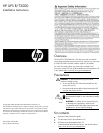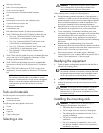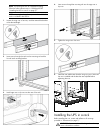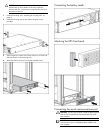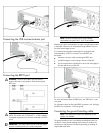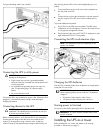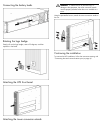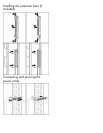
• Warranty information
• Rails, with mounting hardware
• Tower conversion stand (2)
• Front mounting ears (2) and associated hardware
• UPS
• Front bezel
• Mounting ear covers (2) (for rack installation only)
• Communications port/option slot
• REPO port connector block
• Cord retention clips
• Rear stabilization brackets (2) and associated hardware
• The R/T3000h NA/JPN and R/T3000 INT models ship with:
o Two 10 A, 1.83-meter (6-foot) IEC-to-IEC power cords
(142263-001), for load equipment power
o Two 10 A, 2.44-meter (8-foot) IEC-to-IEC power cords
(142263-002), for load equipment power
o Two 10 A, 3.05-meter (10-foot) IEC-to-IEC power cords
(142263-003), for load equipment power
o One 3.66-meter (12-foot) computer interface cable
(397237-002)
• The R/T3000 NA/JPN models ship with a nondetachable input
power cord with an L5-30 plug and a 3.66-meter (12-foot)
computer interface cable (397237-002).
• The R/T3000h NA/JPN models ship with a nondetachable
input power cord with an L6-20 plug and one C13 extension
bar.
• The R/T3000 INTL model has an IEC-20-C19 input power
receptacle for a country-specific cord and one C13 extension
bar.
NOTE: All models ship with a computer interface cable.
The computer interface cable is not needed for normal
operation. To administer the UPS with power management
software, connect the interface cable between the UPS
communications port and the serial port on the host
computer.
Tools and materials
The following tools are required for installation:
• Phillips screwdriver
• 10-mm hex-nut driver
The following items are supplied with the rack:
• Screws
• Hex nuts
• Cage nuts
• Cage nut-fitting tool
Selecting a site
WARNING: To prevent fire or electric shock, install the
unit in a temperature- and humidity-controlled indoor
environment, free of conductive contaminants.
When selecting a site, consider the following factors:
• Elevated operating ambient temperature—If the equipment is
installed in a closed or multi-unit rack assembly, the operating
ambient temperature of the rack environment might be greater
than room ambient temperature. Install the equipment in an
environment compatible with the operating temperature.
• Reduced air flow—In the rack, the rate of air flow required for
safe operation of the equipment must not be compromised.
• Circuit overloading—Consideration should be given to the
connection of the equipment to the supply circuit and the effect
that overloading of the circuits might have on overcurrent
protection and supply wiring. Appropriate consideration of
equipment nameplate ratings should be used when addressing
this concern.
• Reliable earthing—Reliable earthing of rack-mounted
equipment should be maintained. Particular attention should be
given to supply connections other than direct connections to the
branch circuit, such as the use of power strips.
• Electrical requirements—All models require a dedicated
(unshared) branch circuit, suitably rated for the specific UPS as
stated in "Input specifications" in the user guide.
Readying the equipment
1. Check the battery recharge date specified on the label that is
affixed to the shipping carton.
IMPORTANT: Do not use the battery if the recharge date
has passed. If the date on the battery recharge date label
has passed without the battery being recharged, contact
an HP authorized service representative for directions.
2. Transport the packaged unit to its installation location.
3. Unpack the equipment near the rack where the unit will be
assembled.
CAUTION: Always plan the rack installation so that the
heaviest item is on the bottom of the rack. Install the
heaviest item first, and continue to populate the rack from
the bottom to the top.
Installing the mounting rails
WARNING: To reduce the risk of personal injury or
damage to the equipment, be sure that:
• The leveling feet are extended to the floor.
• The full weight of the rack rests on the leveling feet.
• The stabilizing feet are attached to the rack if it is a
single-rack installation.
• The racks are coupled together in multiple-rack
installations.
• Only one component is extended at a time. A rack
may become unstable if more than one component is
extended for any reason.



